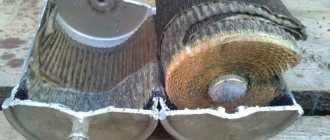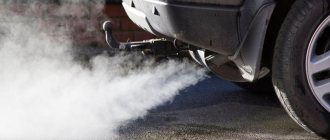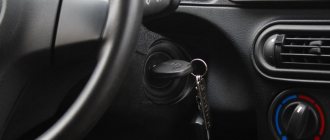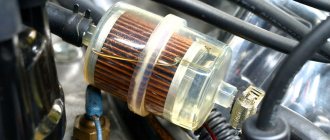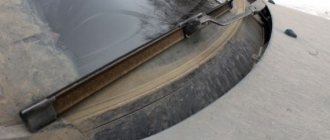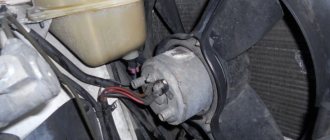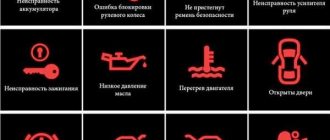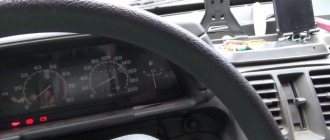The VAZ-2109 model with a carburetor engine is an unpretentious Russian car, characterized by a low price, economical fuel consumption, high maintainability, and very good technical characteristics. However, like any passenger car, it has its own characteristic “diseases”, one of them is that the engine starts and stalls, the carburetor overflows fuel. A similar malfunction occurs in various variants: the engine may stall while driving, the speed decreases when you press the gas pedal (and traction disappears), the engine stops when the car starts moving. Here we will try to consider all the main causes of the problem and the question of how such problems can be solved.
The main reasons for engine stopping while driving or after starting it
There are two main signs when an internal combustion engine (ICE) stalls:
- the motor stops almost immediately after starting (in place, without moving the car);
- the engine turns off (the speed drops to the very minimum) when you try to start moving or switch to a higher load.
The reasons for this behavior of the internal combustion engine are very different and sometimes unexpected; if the engine stalls, barely having time to start, this may be as a result of:
- lack of fuel supply (no gasoline entering the carburetor float chamber);
- somehow the ignition is turned off;
- idle speed disappeared;
- the fuel filter is clogged;
- a partition in the muffler blocked the exit of exhaust gases.
If there is no fuel supply, the fuel pump is most often to blame (on VAZ models 2108, 2109 and 21099 it is of a mechanical type).
To make sure there is fuel supply, you need to remove the central high-voltage wire, disconnect the main fuel pipe from the carburetor and crank it with the starter. If the used pump pumps, gasoline will immediately begin to flow out of the hose; this check should be carried out by two people.
Sometimes a situation arises when a partition inside the muffler blocks the outlet of exhaust gases, the engine “chokes” and does not work. When the exhaust is “half-covered,” the car simply drives poorly – sluggish acceleration, limited maximum speed. When the muffler pipe is completely blocked, the internal combustion engine starts and stalls almost instantly. Checking this version is quite easy:
- one of the diagnostic participants (also needs to be done together) starts the engine;
- the second person observes, placing his palm on the exhaust pipe, whether there is any exhaust of gases.
Another reason for the internal combustion engine to stop is the lack of idle speed in the carburetor; a similar defect is typical for front-wheel drive VAZs. At this point we will dwell in more detail and consider various options for the manifestation of the malfunction and ways to eliminate it.
Checking high voltage wires
When everything is in order with the ignition system, but the problem has not yet been solved, then the high-voltage wires are diagnosed. Under stable loads they can also fail.
As a rule, if the problem comes from the wiring, then the insulation or conductive parts in it are destroyed. Based on this, the electricity does not reach its destination and there is no spark. If the insulation is damaged, a breakdown occurs between the residential and vehicle ground. As a result, some of the electricity is lost, and this leads to a loss of spark power.
Checking the wires is carried out similarly to diagnosing spark plugs. Additionally, examine the wire resistance parameters. The range of acceptable values should be from 0.4 to 0.9 kOhm.
Problems with idle speed of VAZ models 2108-09-099
VAZ cars of the “ninth” family are equipped with Solex carburetors; they differ in modifications depending on the engine size (1100, 1300 or 1500 cm³). Externally, the carburetor units (CU) are almost completely identical, the difference lies in the internal “filling”: jets of different cross-sections, an accelerator pump nozzle (APA), emulsion tubes, and diffusers are installed. The idle speed system (IDS) in these CUs is responsible for the stability of minimum engine speeds, as well as for fuel consumption.
The Solex XX system includes the following elements:
- channels for supplying fuel and air;
- air jet;
- solenoid valve (EMV) with fuel jet;
- speed screw;
- adjusting needle for the quality of the fuel-air mixture.
The quantity screw sets the position of the throttle valve, leaving it slightly open, and the fuel mixture at low speeds, under the influence of vacuum, enters the engine through the carburetor and passes through the XX channels. Dosing of the mixture is ensured by jets, enrichment or combination is ensured by an adjusting needle, and the fuel supply is controlled using an EMG.
If the solenoid valve does not operate, or the channels are clogged, fuel and air in the required proportions will not flow into the intake manifold, idle speed will disappear. Because of this, various problems occur during the operation of the internal combustion engine:
- the engine starts and stalls because there is no idle speed;
- even if there is XX, the engine still works unstable, and when you try to start moving, it stops;
- the car loses dynamics, and when you press the gas, on the contrary, the car picks up speed.
If, with such signs, you unscrew the EMG a little, the engine will gain speed at idle, but this method will not solve the problem - the car will still not drive normally, and besides, fuel consumption will increase.
Ignition module
As noted, in addition to the normal supply of fuel, a spark is required for the engine to operate. One of the elements in the car’s design that is responsible for sparking is the ignition module.
This element controls the ignition coil, and also sets the ignition timing and, if necessary, changes it. If the module malfunctions, the following symptoms are observed:
- “Trippling” of the motor;
- Misfires and error display in the on-board computer;
- The "Check Engine" light is on on the dashboard;
- Paired cylinders (1 and 4 or 2 and 3) do not work;
- Floating speed and difficulty starting a cold engine.
Helpful : Hard to start when cold
If a VAZ 2114 (injector) starts and immediately stalls, you should immediately check the ignition module for a malfunction. To check the version with a faulty module, you should install a known working MZ and make sure that it is faulty. If the problem continues, you should start checking the sensors.
What to do if idle speed disappears
If the car is unstable at idle, drives with dips, or constantly stalls, first of all you need to check the functionality of the solenoid valve. We check it as follows:
- we start the engine at low speed, and to prevent the engine from stalling, use the quality screw to add speed;
- with the internal combustion engine running, without pressing the gas pedal, pull off the EMG wire plug;
- if the nature of the work has not changed, you need to check the presence of power on the EMG; to do this, turn off the engine, turn on the ignition, and bring the chip with the wire to the valve. If there is voltage, a slight click should be heard (to hear it better, you can repeat the test several times).
If there is no power, most likely the economizer control unit has failed, or there is a bad contact somewhere in the wiring (probably a break). This problem needs to be fixed; it is possible that the reason for the absence of XX is hidden here.
But let’s say there is voltage on the valve, but the fault is still present. Now we need to check the operation of the valve itself, we perform this operation like this:
- remove the fuel jet from the EMG;
- We fix the valve body to the ground terminal of the battery, and apply plus to the EMG contact (you can also use it from the battery using a piece of wire);
- when the “plus” is applied, the solenoid valve needle should be retracted (triggered); if this does not happen, then the valve is faulty.
What else should you do if the idle speed still does not appear? It is imperative to clean the EMG nozzle using compressed air, and also purge the XX channel. You can try to perform this procedure without removing the carburetor; it is performed in the following sequence:
- with the solenoid valve and air filter housing removed, we start the engine (this needs to be done together; you cannot turn on the ignition or work with the carburetor alone);
- while manually controlling the throttle, press the XX channel with your finger;
- use the throttle valve to “off the gas” several times, release your hands, and allow the internal combustion engine to work for some time without the valve;
- we stop the engine, put the EMG and wire in place, check if the idle speed has appeared.
A sure sign that the carburetor is not working correctly is a visually noticeable stream of gasoline that flows from the nozzle (“spout” of the accelerator) while the engine is running at low speeds. Even in such cases they say that the carburetor is “flowing”; if the CU is in good condition, this should not happen.
Determining the quality of the spark
At this stage, you need to understand whether there is voltage on the spark plugs. To do this, just unscrew one spark plug and connect the central electrode to the high-voltage wire. Next, ensure that the threads are in contact with the ground of the car and turn on the ignition. A stable spark of blue (white-blue) color indicates that everything is fine with the ignition.
Check the remaining spark plugs in the same way. Because a common reason for an engine to fail to start is the failure of one of these parts.
Initially, the engine starts and tries to operate on two or three cylinders. You may notice that the internal combustion engine is shaking and the vibration from it increases.
After working for a while in this mode, the engine will stall.
Cylinders with non-functioning spark plugs are simply filled with too much gasoline and the situation will repeat itself when the engine is restarted. If there is a spark on all spark plugs, evaluate their color and size. Yellow/red color and small size also indicate that the car will start and subsequently stop working.
At this stage, it is enough to replace the failed spark plugs. When purchasing parts, pay attention to the manufacturer’s recommendations regarding clearance and heat rating parameters.
Effect of air leaks in the fuel system
Unstable operation of the internal combustion engine, failures during acceleration of the car can also occur due to air leaks in the fuel system (TS), because as a result of the appearance of excess air mass, the proportion of the mixture necessary for the complete combustion of gasoline in the cylinders is disrupted. Air suction can occur:
- between the top cover and the main body of the carburetor due to metal deformation;
- due to a loose fit of the lower platform of the HRSG to the intake manifold;
- as a result of a rupture of the hose or its poor connection with the fittings of the vacuum brake booster (VUT);
- due to a malfunction of the vacuum booster itself.
It is quite easy to check whether VUT affects the stability of the engine; you need to disconnect the “vacuum” hose from the intake manifold, plug the fitting, and start the engine.
If, after installing the plug on the fitting, the engine operation is leveled out and it no longer “trips”, we have correctly identified the cause of the malfunction. Sure signs of leakage in such cases: a noticeable hiss of air in the area of the “vacuum chamber”, engine stopping or a sharp drop in speed after pressing the brake pedal. The power mode economizer (EMR) also affects the stability of the idle speed; more precisely, its diaphragm, if it is broken, the engine will not work normally at low speed. In any case, it is worth checking the condition of this part; you can remove the diaphragm without dismantling the carburetor (unscrew 3 screws).
What are the causes of car malfunctions?
If your car starts to have such a problem that it stalls as soon as it starts, then it’s time to take the car in for a technical inspection. You will like several real reasons, and until you find the true one, you will have to go through almost half of your car. We will consider below where you should mainly pay attention.
See:
- The car alarm system is not working properly. Modern alarm systems that are connected to the central control unit have many additional gadgets that can negatively affect engine starting. Sometimes even electronics can malfunction and not work correctly. The auto program does not identify the start and stops the supply of electricity to the injectors, which, accordingly, deprives the spark (no ignition).
- The idle speed control is inoperative. There are possibly two reasons for its incapacity - either it is too clogged, or it is not working and will need to be replaced. Poor quality fuel causes blockage and valve failure. Blockages clog the channels through which car mixtures along with oxygen must flow to the parts, this disrupts the ignition process.
The influence of the accelerator pump on the operation of the VAZ-2109 internal combustion engine
Unstable engine operation, stalls, sluggish acceleration, etc. can also occur due to malfunctions in the Solex accelerator pump system. Here are the main causes of problems on the “nine”:
- incorrect dosage of the sprayer (“spout” or “elephant”), as well as clogging of this channel;
- torn or dried out diaphragm;
- incorrectly selected accelerator pump drive (“flag”).
Factory nozzles for the “nine” usually have two “spouts”, which are distributed among the chambers, but in the “secondary” fuel injection turns out to be completely unnecessary, at least that’s what many craftsmen think. The modernization of this part is the transfer of both “spouts” to the “primary chamber” (primary chamber), another option is the installation of a single sprayer from the KU for the Niva.
When bending the tubes, it is important to install them so that the injection passes exactly between the carburetor body and the damper, without hitting these parts, otherwise there will be no effect from such tuning.
The injection is checked, of course, with the carburetor removed, without the top cover, with the float chamber filled with gasoline. When you open the throttle (simulating pressing the gas pedal), you should get two even jets that pass through the lower part of the body without hitting it.
Related articles:
- How to get your license back after being revoked for drunkenness? Many people are interested in the question of how to get a license after being deprived of it for drunkenness: what kind of rules exist, and do you need to retake the exam again? This article will look at what […]
- How to properly store tires and care for car tires In many regions of Russia, due to snowy winters, it is necessary to install winter tires on the car in the cold season, and summer tires in the warm season, all-season tires for harsh […]
- Replacing the master and working brake cylinders on VAZ cars Replacing the brake cylinder is a simple job, but extremely important; driving with faulty brakes is strictly prohibited. Diagnostics and repair of the brake system (TS) must be carried out [...]
Let's sum it up
If your nine stalls immediately after it starts and does not want to idle, then first of all you need to check:
- Is the ignition system working?
- Is the power system working?
First, make sure that you haven’t run out of fuel (yes, that happens). If there is gasoline in the tank, open the hood and do a visual inspection of the engine and carburetor. Make sure all the wires are in place (at least none of them are loose or burnt). The rburetor, fuel pump and gasoline hoses also need to be carefully examined. If gasoline leaks somewhere, you can’t drive any further, you can’t even start the car. It is best to use the services of a tow truck. It is also necessary to check whether the oil level in the engine meets the established standards (look at the dipstick marks) and the antifreeze level. To superficially check the adequate operation of the ignition system, you need to check the contacts. An ohmmeter is used for this. If everything is normal, the device will show zero resistance. Otherwise, you will have to replace the contact group or the entire ignition switch. The most important thing is to remain calm if the car stalls while driving. Remember to turn on your hazard lights and try to stop slowly and smoothly (or pull over to the side of the road) so as not to interfere with other road users.
Why does the VAZ 21 0 9 injector start and stall after 5 seconds? Problems with malfunctions, please tell me?
If the nozzle gets stuck, there could be several reasons:
- Fuel pressure regulator malfunction
- The fuel tank is not completely filled
- Crankshaft position sensor malfunction
- Faulty spark plug
- The fuel pump primary filter is dirty
5 Good answer
At idle the revs drop and rise slightly. When the car (VAZ 2115) is completely warmed up, it begins to shake. What are the reasons?
Sounds a lot like an air leak. Air can enter through the intake manifold seals or through the injector rings. It is also possible that the plastic manifold is broken.
The car starts in cold weather and immediately stalls
Low temperatures can only affect engine stability if the fuel pump is faulty. Are you trying to start the engine in severe cold, it starts, but after a few seconds it goes out? Try pumping fuel using the pump lever. If the situation has changed, look for a problem in the pusher. In addition to the fact that its seals can be worn, which also become stiffer in severe frost, it itself can become covered with ice. All this prevents him from moving. As a result, less fuel enters the carburetor, which again leads to a leaner fuel mixture.
